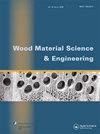三种热带木材在Maroua(喀麦隆)雨季自然对流中太阳干燥动态响应的实验和理论分析
IF 2.1
3区 农林科学
Q1 MATERIALS SCIENCE, PAPER & WOOD
引用次数: 3
摘要
摘要本工作旨在研究和表征三种热带木材的干燥动力学、热质传递系数、密度、热渗出率、热扩散率和杨氏模量:ayous(三倍木)、sapelli(Entandorphragma cylindrium)和iroko(Milicia excelsa)。比较了在自然对流条件下使用廉价太阳能烘干机进行烘干和在露天条件下进行烘干。这项工作的新颖之处在于,在喀麦隆气候恶劣的马鲁阿市,在降雨量最大的时期进行了一项实验研究。密度受板材中样品来源的影响,并随含水量线性增加。在30&per;在湿度(d.b)方面,sapelli、iroko和ayous的平均密度分别为1000、760和600 kg/m3。热渗出率和热扩散率随水分含量线性增加。三种木材的热扩散系数非常接近(2 × 10−7 m2/s,速度为30&per;湿度(d.b))和热渗出率随木材密度的增加而增加,在30&per;湿度(d.b)。热质传递系数受昼夜影响,在1.5之间变化 × 10−8–1.8 × 全局传质系数为10−7 m/s,传热系数为1.8–6.5 W/(m2K)。根据杨氏模量值和干燥动力学的变化,露天条件下的干燥比太阳能干燥器中的干燥更快,不推荐使用。所有样品的平衡湿度接近10&per;(d.b)。本文章由计算机程序翻译,如有差异,请以英文原文为准。
An experimental and theoretical analysis of the dynamic response of solar drying in natural convection under rainy month of Maroua (Cameroon) of three tropical wood species
ABSTRACT This work aims to study and characterize the drying kinetics, the heat mass transfer coefficients, the densities, the thermal effusivities, the thermal diffusivities and Young’s modulus of three tropical kinds of wood: ayous (triplochiton scleroxylon), sapelli (Entandrophragma cylindricum) and iroko (Milicia excelsa). A comparison has been doing between drying using a low expensive solar dryer in natural convection and drying using open-air conditions. The novelty of this work is to use an experimental study during the rainiest period in the city of Maroua, one city in Cameroon with a hard climate. Densities are influenced by the origin of the samples in the plank and increase linearly with the moisture content. At 30&per; of humidity (d.b), average densities of sapelli, iroko, and ayous were equal to 1000, 760 and 600 kg/m3 respectively. Thermal effusivities and thermal diffusivities increase linearly with the moisture content. Thermal diffusivities of the three kinds of wood are very near (2 × 10−7 m2/s at 30&per; of humidity (d.b)) and thermal effusivities increase with the wood densities with values located from 560 to 620 J/(K.m2.s0.5) at 30&per; of humidity (d.b). The heat mass transfer coefficients are influenced by the night and day and vary from 1.5 × 10−8–1.8 × 10−7 m/s for the global mass transfer coefficients, and from 1.8–6.5 W/(m2K) for the heat transfer coefficients. According to the variations of the values of young’s modulus and the drying kinetics, drying in open-air conditions is more rapid and not recommended than one in the solar dryer. The equilibrium humidity of all samples is near 10&per; (d.b).
求助全文
通过发布文献求助,成功后即可免费获取论文全文。
去求助
来源期刊

Wood Material Science & Engineering
Materials Science-General Materials Science
CiteScore
3.90
自引率
13.60%
发文量
131
审稿时长
79 days
期刊介绍:
Wood Material Science and Engineering is a multidisciplinary and international journal with the aim to serve at the forefront of the wood science and technology field. The journal publishes original articles on basic and applied research dealing with:
-Wood material science with emphasis on: water-wood relations, wood durability, wood modification, wood mechanics, wood composites, engineered wood products, energy conversion and eco-efficient wood based products.
-Wood engineering, i.e. the application of the wood material science to designing, processing and manufacturing of forest products and the use of machines and processes for these products. Products of concern are biofuels, sawn wood and further refined products such as structural elements, interior fittings and furnishings. In this aspect the link between the nature of the wood material and the properties of the final wood products in-service and its impact on the environment is of outmost importance.
High quality review papers may also be accepted but the topic should be discussed with the editor before submission.
 求助内容:
求助内容: 应助结果提醒方式:
应助结果提醒方式:


